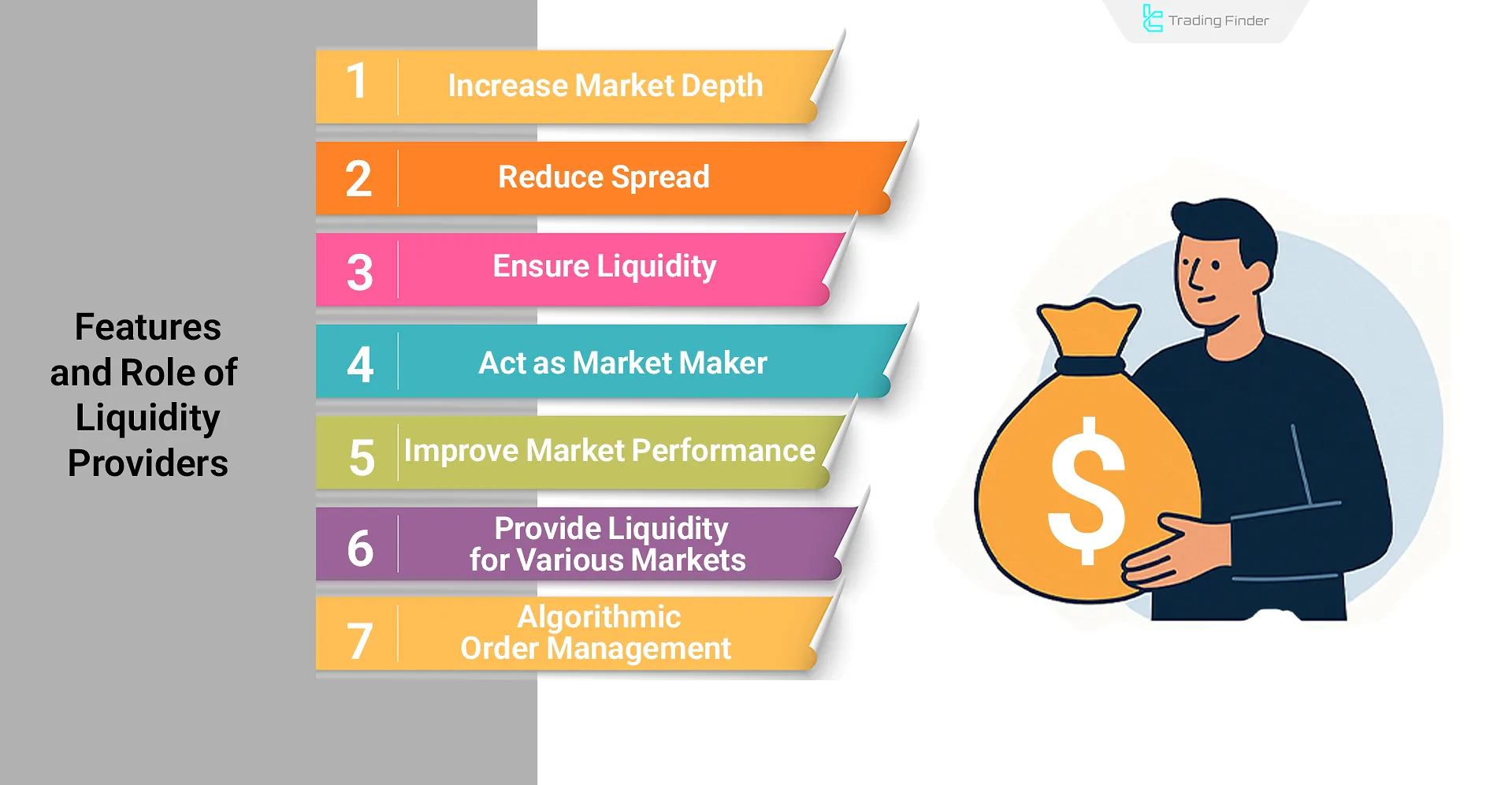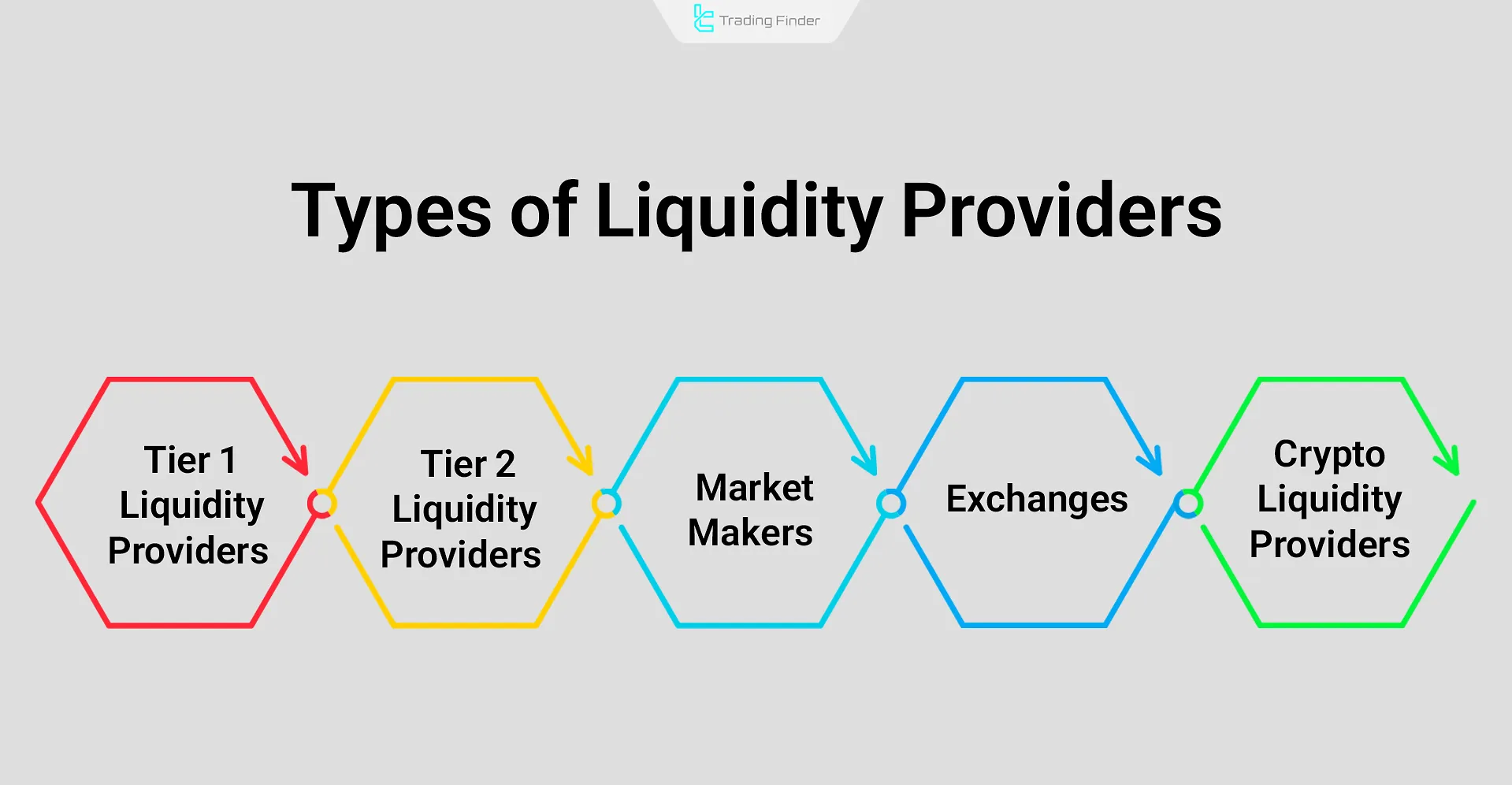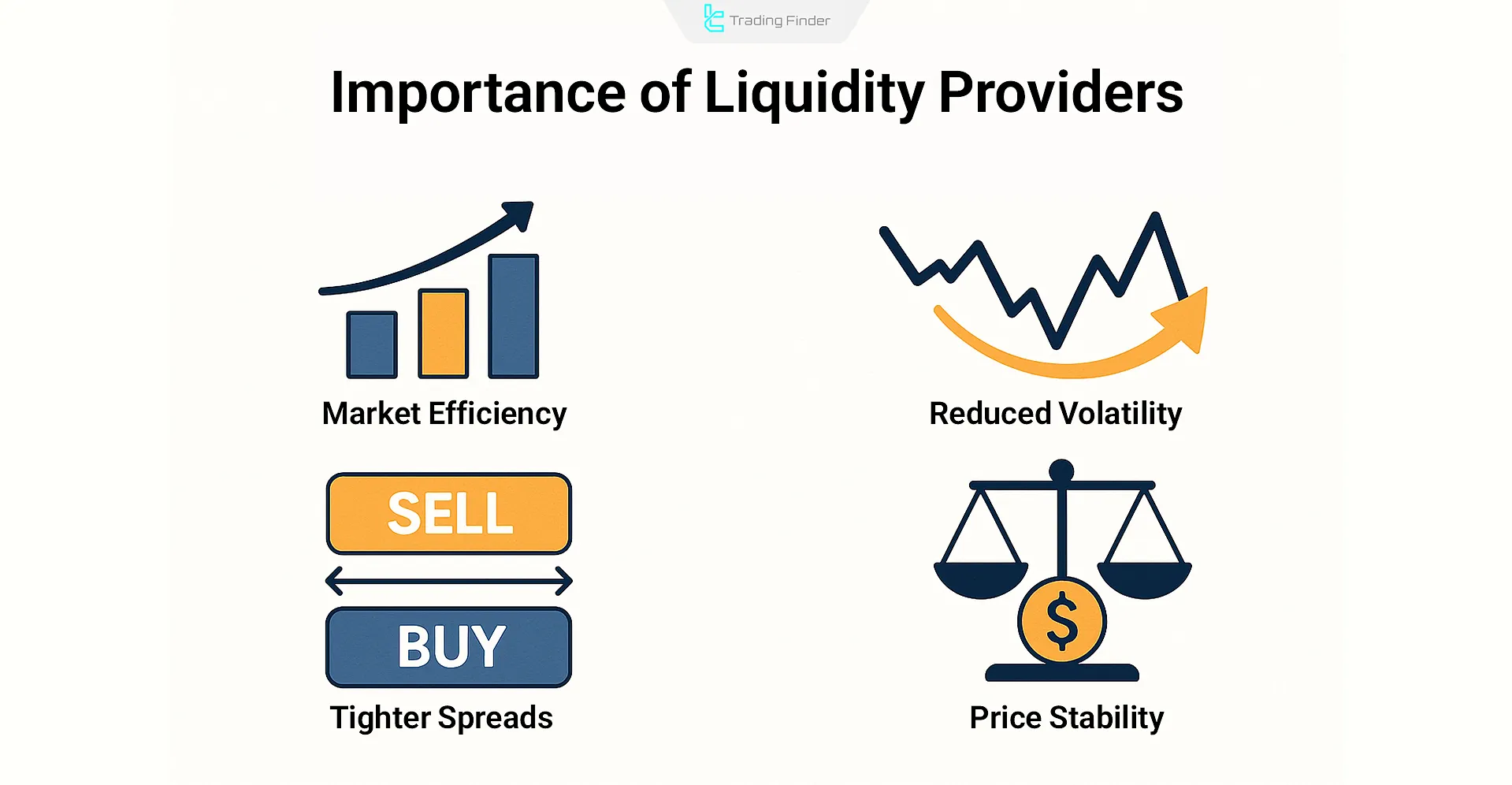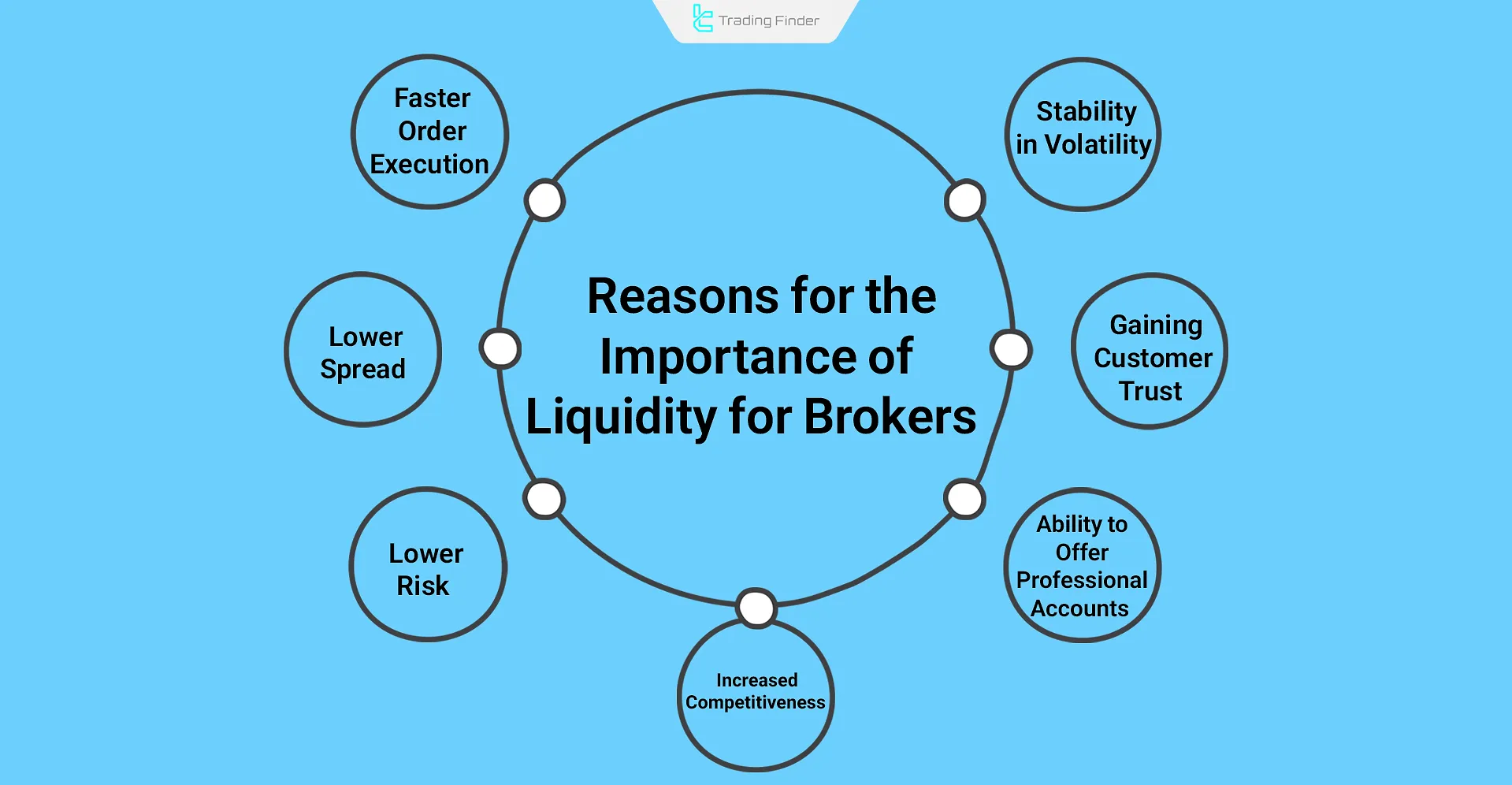Liquidity Providers supply the required capital for trading in Forex, cryptocurrency, stock markets, and other markets. Liquidity Providers provide bid and ask prices, and the speed of trade execution depends on their presence.

Who is a liquidity provider?
Liquidity Providers are individuals or companies in financial markets, especially in Forex, stocks, and cryptocurrencies, that provide the necessary liquidity for transactions.
They enable traders’ orders to be executed quickly and smoothly by offering bid and ask prices to the market.
Features and role of Liquidity Providers:
- Increase market depth: Offering large buy and sell orders to reduce sharp price fluctuations;
- Spread reduction: Narrowing the gap between bid and ask to lower trading costs;
- Liquidity ensurance: Enable fast buying and selling of assets without significant price impact;
- Act as market makers: Continuously quoting bid and ask prices to keep markets active;
- Improve market performance: Stabilizing prices and preventing unusual volatility;
- Support official and OTC markets: Ensuring smooth operation in all types of markets;
- Utilize advanced technologies: Use algorithms and automated systems for order and risk management.

What are the types of liquidity providers?
In financial markets, Liquidity Providers play a key role in ensuring the fast execution of orders with minimal price difference. Liquidity Providers are divided into several main categories:
- Tier 1 Liquidity Providers
- Tier 2 Liquidity Providers
- Market Makers
- Exchanges
- Decentralized Crypto Liquidity Providers in DeFi

Tier 1 Liquidity Providers
Tier 1 Liquidity Providers are the main players and largest sources of liquidity. Most of them are banking, financial, and investment institutions (such as Deutsche Bank, J.P. Morgan, Goldman Sachs, and others).
Some are not banks but, with very high financial strength, play a vital role in providing Forex liquidity.
Tier 2 Liquidity Providers
Tier 2 Liquidity Providers are companies that have access to Tier 1 liquidity and deliver it to clients using technological tools.
These companies work with several providers, and the more partners they have, the more liquidity and market depth they can offer.
Some brokers also act as secondary Liquidity Providers; however, not all brokers are Liquidity Providers.
Market Makers
Market Makers actively set bid and ask prices and are often the counterparty in trades.
Market Makers are individuals or institutions in financial markets that continuously provide buy and sell quotes, thereby supplying liquidity.
By simultaneously offering bid and ask prices for a particular asset, they create the bid-ask spread.
Decentralized Crypto Liquidity Providers in DeFi
In decentralized finance (DeFi), ordinary users can act as LPs by depositing assets into liquidity pools.
In other words, Liquidity Providers in DeFi are users who deposit their assets (such as cryptocurrencies) into liquidity pools of decentralized exchanges.
These pools are smart contracts that lock users’ assets to provide the liquidity required for trading.
Importance of Liquidity Providers
The importance of Liquidity Providers in financial markets is critical. They guarantee market dynamism, efficiency, and tradability. Without them, many markets would stagnate or face severe volatility.
Choosing the right broker heavily depends on its Liquidity Providers and affects order execution quality.
In cryptocurrency markets, decentralized Liquidity Providers (LPs) play a vital role in facilitating trades and boosting the efficiency of decentralized exchanges (DEX).

Difference between Market Makers and Liquidity Providers
The difference between Market Makers and Liquidity Providers lies in their roles, operational structures, and type of market interaction. Below we examine these differences in more detail.
Difference between Market Makers and Liquidity Providers:
Feature | Market Maker | Liquidity Provider |
Definition | An institution that continuously provides bid and ask prices to maintain market liquidity | An institution or individual that provides its capital to execute buy and sell orders |
Role in the Market | Creates prices and executes trades | Executes orders without direct involvement in pricing (especially in STP and ECN models) |
Type of Market | Mostly in Dealing Desk models or brokers’ internal markets | Mostly in interbank markets and ECN/STP brokers |
Counterparty | May directly trade with clients (internal broker) | Usually not the direct counterparty; clients’ orders are passed to them |
Source of Income | Earns from spreads, bid-ask differences, or trading against clients | Earns from interbank spreads, trading volumes, and small markups |
Level of Risk | High; since it may take the opposite side of client trades | Lower; usually operates with hedging or risk management strategies |
Main Objective | Maintains liquidity by continuously quoting bid and ask prices | Provides market depth and increases order execution speed |
Price Control | Sets prices or adjusts them internally | No; prices are usually sourced from interbank or external markets |
Dependence on End User | High; directly interacts with end clients | Low; usually connected through brokers or liquidity networks |
Why is liquidity level important for brokers?
Liquidity levels are critical for brokers because they directly impact service quality, execution speed, trading costs, and client satisfaction. Reasons include:
- Faster execution: Reduced delays and slippage;
- Lower spreads: Reduced trading costs for clients;
- Lower risk: Easier order execution with Liquidity Providers;
- Stability in volatility: Better price control in volatile markets;
- Client trust: Proof of access to reputable liquidity networks;
- Ability to offer professional accounts: Such as ECN and Raw Spread;
- Competitive advantage: Attracting professional and institutional traders.

Profits and losses of Liquidity Providers
Contrary to common belief, Liquidity Providers do not only earn from spreads; their activity can be both profitable and risky depending on business model, target market, hedging strategy, and trade structure.
Profits and losses of Liquidity Providers (LPs):
LP Profits | LP Losses and Risks |
Income from bid/ask spreads | Risk of sudden market moves (Adverse Selection) |
Commission/Fee Income | Inventory Risk |
Arbitrage and profitable algorithms | Impermanent Loss in DeFi |
Rebates and cash incentives | Low liquidity risk in special conditions |
Profit from market psychology inefficiencies | Price manipulation or Flash Loan Attacks |
Although liquidity provision is a sustainable and profitable model, it requires advanced risk management, fast infrastructure, and automated position hedging; otherwise, it can be loss-making.
Conclusion
Liquidity Providers (LPs) are the main players in financial markets responsible for quoting prices and providing large order volumes.
These entities, including major banks, financial institutions, Market Makers, and even DeFi users, play a vital role in narrowing spreads, improving order execution speed, and maintaining market stability.
The level of liquidity provided by them directly impacts brokers’ service quality and client satisfaction.





